Arcteryx Altitude Sports X Arcteryx Mens Cerium Lt Hoody Review
As your next-to-skin article of wear, a baselayer plays a fundamental office in pulling wet abroad from the body and regulating core temperature. It's far easier to justify purchasing a nice down jacket, simply a baselayer can be merely every bit of import for activities like skiing, hiking, and climbing. To start, avoid cotton (similar the onetime adage "cotton wool kills"). Y'all'll need a fabric that volition proceed you warm when wet and dry out quickly, and merino wool and polyester are the most common choices. Beneath are our picks for the best baselayers of 2022. For more information, see our baselayer comparison table and ownership advice below the picks.
Our Squad's Baselayer Picks
- Best Overall Baselayer:Smartwool Merino 250 i/4-Zip
- Best Synthetic Baselayer:Patagonia Capilene Midweight Crew
- Best Budget Baselayer:Helly Hansen Lifa Stripe Crew
- Best Heavyweight Baselayer for the Cold: Patagonia R1 Air Zip-Neck
- Best Lightweight Baselayer for Mild Weather: Smartwool Merino 150 Crew
- Most Durable Baselayer: NW Alpine Black Spider Hoody
Best Overall Baselayer
one. Smartwool Merino 250 1/iv-Null ($105)
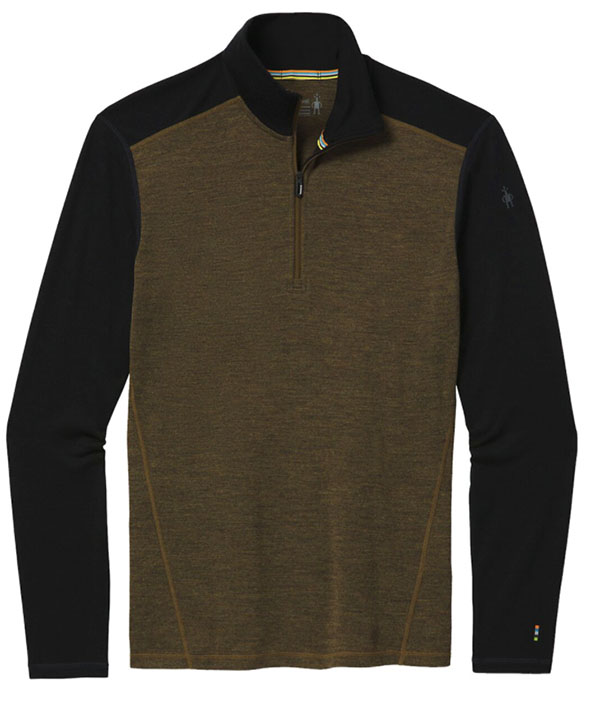 Cloth: 100% merino wool
Cloth: 100% merino wool
Category: Midweight
Weight: x oz.
What we like: Extremely soft, warm, and resists h2o and stink.
What we don't: Pricey and requires good care to last.
Smartwool has been the manufacture leader in baselayers for years, and merino wool is the most sought-later on material for the task. Fabricated with 100 percent merino (many of the baselayers below are blends or synthetics), the 250 Quarter-Nada is the whole package: It's warm, super soft against the skin, resists moisture, and doesn't agree stink similar the polyester options on the listing. All in all, it's a great baselayer for skiing and other winter sports, and even has a UPF 50+ rating for use as an outer layer in more than mild weather. Based on the popularity of the Smartwool 250, information technology's made in a number of versions, including a Crew ($100) and Hoodie ($135). But when active, we appreciate the power to lower the zip and regulate heat.
The Smartwool is the total packet, but merino wool isn't cheap: You can salve with i of the blends or polyester baselayers below, including Patagonia's popular Capilene. That said, we far prefer merino for its coziness, temperature regulation, ability to insulate when wet, and resistance to smell. With polyester, you'll probable accept to wash and change your baselayers quite ofttimes, whereas wool keeps performance high over the form of a multi-mean solar day backcountry or ski trip. The principal downside to consider is merino's lack of durability—particularly if y'all frequently throw information technology in the dryer—but it'south worth the tradeoff for the high levels of comfort and performance. Amid the growing core of merino options, we think Smartwool's 250 provides the all-time residual of versatility, quality, and value.
Run into the Men's Smartwool Merino 250 See the Women's Smartwool Merino 250
Best Constructed Baselayer
2. Patagonia Capilene Midweight Crew ($69)
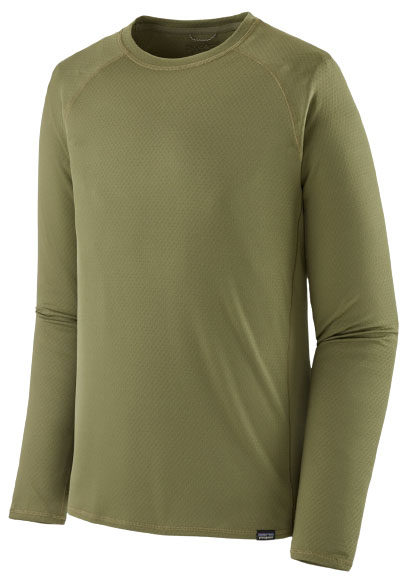 Cloth:100% recycled polyester
Cloth:100% recycled polyester
Category: Lite/midweight
Weight: 6.2 oz.
What we like: Cheaper and more durable than merino wool.
What we don't: Not quite as soft.
Choosing synthetics over merino wool has clear upsides, the most notable being cost and durability. For just over half the price of the Smartwool to a higher place, the polyester Capilene Midweight by Patagonia offers similar warmth and moisture-wicking capabilities. And it probable will terminal for many seasons—we accept Capilene tops that are multiple years quondam and counting despite heavy apply. And while synthetics aren't clean-living when it comes to their environmental impact (they often rely on fossil fuels for product and can leach plastics into the water with each washing), information technology helps that Patagonia crafts the Capilene Midweight with 100-per centum recycled materials.
What practice yous sacrifice by going with a synthetic baselayer? Polyester is decently comfortable but not as soft confronting the skin, and it doesn't regulate body temperature or repel odor quite too as wool. This doesn't mean that your Capilene will become stinky super quickly—and Patagonia has made strides in this expanse with an anti-smell HeiQ Fresh treatment—only you will find yourself putting it through the wash more ofttimes. But wool tin can be finicky and not everyone wants to spend $100 or more than on a baselayer, which is why we love Patagonia's Capilene line. For more warmth, try the Capilene Thermal Weight.
Encounter the Men's Patagonia Capilene Encounter the Women's Patagonia Capilene
Best Budget Baselayer
iii. Helly Hansen Lifa Stripe Coiffure ($45)
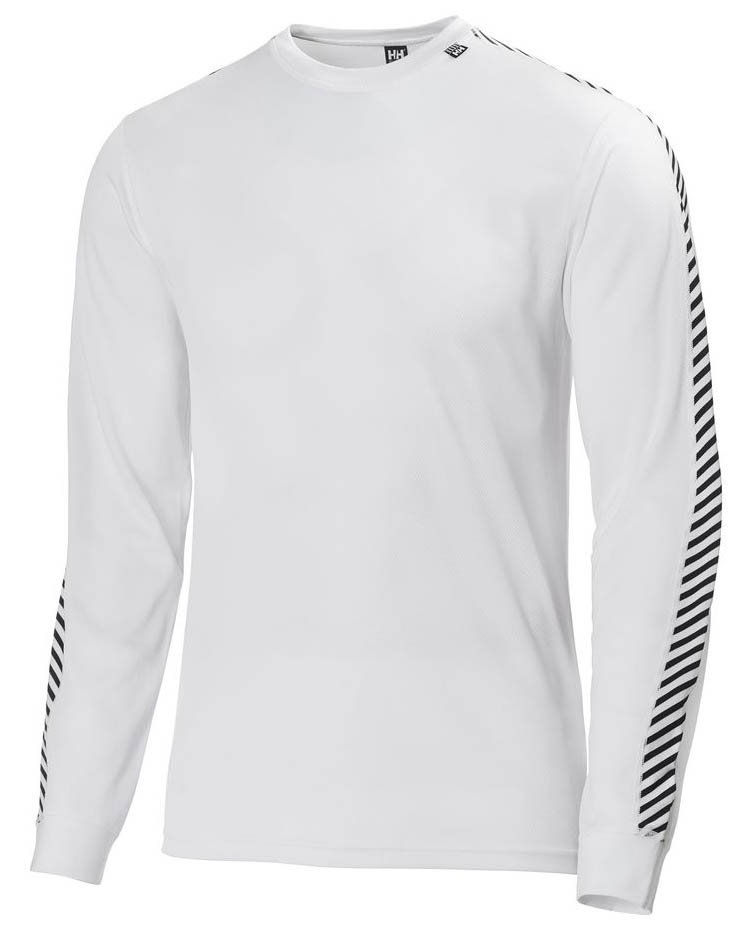 Cloth: 100% polypropylene
Cloth: 100% polypropylene
Category: Lightweight
Weight: 5.ane oz.
What nosotros like: Wicks moisture well and a great value.
What we don't: Not equally warm as other baselayers on this list.
At that place's a lot to like about this lightweight agile baselayer from Helly Hansen. At just $45, information technology'due south one of the cheapest options on this list yet still will keep y'all dry and decently warm in most atmospheric condition. The headliner is the Lifa fabric, which is made from Polypropylene and specializes in wicking moisture away from the peel (information technology does so much better than polyester). Forth with a nice athletic fit, the Lifa Stripe is great for active skiers and other loftier-output activities like climbing and hiking.
The downside of Polypro compared to polyester or nylon is that it isn't as warm. The Lifa Stripe Crew falls into our lightweight category, meaning that it provides some insulation but requires a good midlayer or insulated shell in cold conditions. Information technology's worth the tradeoff for high-output use, but if y'all prefer warmth over breathability, check out REI's budget-oriented polyester lineup (including the $40 Lightweight Coiffure beneath). And information technology's worth noting that Helly Hansen now offers the midweight Lifa Merino Crew ($100), which features a merino wool exterior and Polypro lining.
See the Men's Helly Hansen Lifa Stripe See the Women's Helly Hansen Lifa Stripe
All-time Heavyweight Baselayer for the Cold
4. Patagonia R1 Air Zip-Neck ($119)
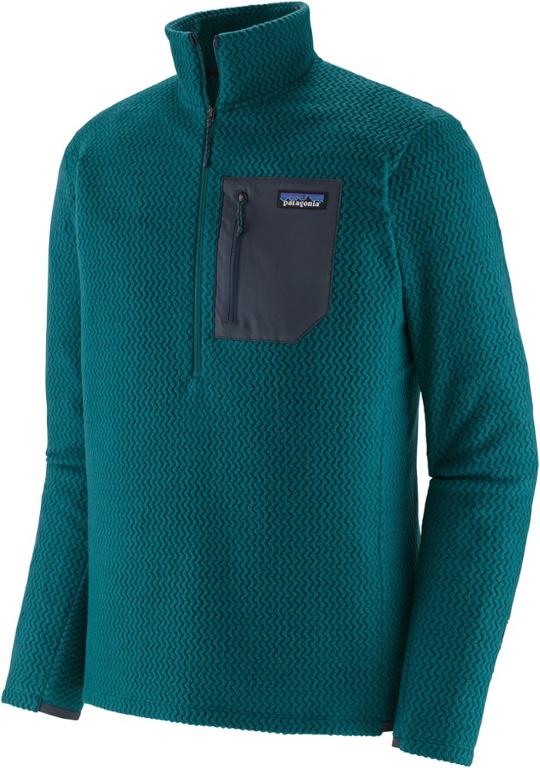 Material: 100% polyester
Material: 100% polyester
Category: Heavyweight
Weight: 10.2 oz.
What nosotros similar: Warm for the weight yet yet breathable and quick-drying.
What we don't: Too warm for near baselayer applications.
Patagonia's R1 collection has long been a staple of their lineup, and the R1 Air more recently joined the team with a highly technical design. Using hollow-core yarns and zig-zag patterning, the 100-percent-recycled polyester fabric traps heat however allows air to pass from the within out, resulting in a breathable yet warm layer that'southward impressively lightweight. And when you do offset to sweat, the polyester finer wicks moisture and dries out apace. Patagonia rounds out the build with a functional 1/4-zip design to trap warmth or release excess heat, sleek off-shoulder seams, and a pocket-size zippered chest pocket. It all adds upwardly to a wildly mod, loftier-performance baselayer and one of the warmest offerings hither.
Technically considered a fleece, the R1 Air toes the line between our baselayer and midlayer categories. As a baselayer, information technology's decidedly heavyweight, which means y'all'll want to save information technology for especially common cold winter days. On the other mitt, information technology provides less warmth than the 100-pct-wool Woolx Glacier Long Sleeve Crew below, although the focus on breathability boosts its appeal for high-output pursuits (and it's effectually $30 cheaper to kick). Patagonia also offers its latest R1 Air in both a Crew and a Full-Nothing Hoody version, the latter of which is best suited for midlayer employ.
See the Men's Patagonia R1 Air Zip-Neck See the Women's Patagonia R1 Air Zip-Neck
Best Lightweight Baselayer for Mild Weather
five. Smartwool Merino 150 Crew ($85)
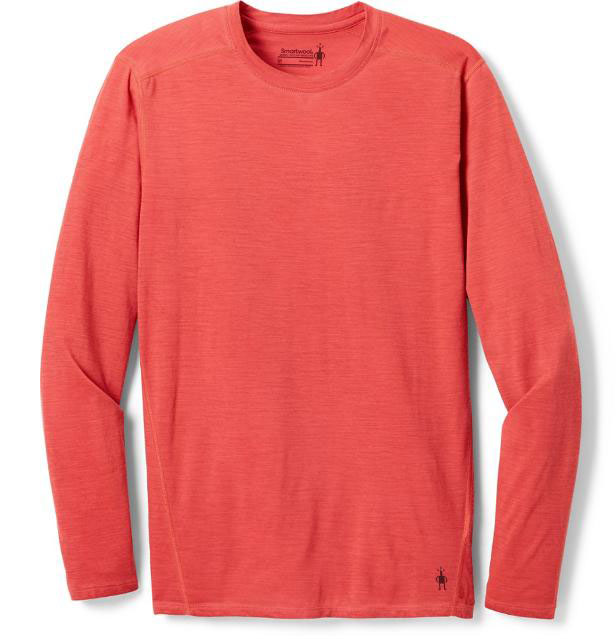 Materials: 87% merino wool, 13% nylon
Materials: 87% merino wool, 13% nylon
Category: Lightweight
Weight: 6 oz.
What we like: A peachy option for cool days and summer nights.
What we don't: Thin materials crave more care.
We've already listed the Smartwool Merino 250 as our top pick, but we'd exist remiss not to include another stellar baselayer in the 150 Crew. The build quality is similar: Smartwool adds thirteen percent nylon to the mix for a heave in durability, the weight goes down significantly to 6 ounces (the lack of the zipper matters here besides), and you lot get the aforementioned minimalist seams for comfort. Compared to the warm 250 in a higher place, the 150 is lighter in weight and ideal for uses like leap skiing, shoulder season hiking, and absurd summer nights. You'll feel similar you are wearing much less baselayer, but the heave in coziness and moisture-wicking capabilities are however there.
Information technology's worth noting that Smartwool likewise offers its techy Intraknit Merino 200, which splits the difference between the 150 here and the 250 above. This functioning piece is virtually one-half polyester/elastane (it's 53 percentage merino), incorporates low-profile seams, and has body mapping with mesh panels throughout for improved ventilation. We haven't yet had the chance to give the Intraknit baselayer an extended test, but it'due south an intriguing choice for high-output activities in cold weather when you want a layer that's both warm and exceptionally breathable (for a similar culling, see Icebreaker'south Zone Coiffure below). But for mild summertime temperatures, the Merino 150 is $35 less and likely all the insulation you'll need.
See the Men's Smartwool Merino 150 Crew See the Women's Smartwool Merino 150 Coiffure
Most Durable Baselayer
6. NW Alpine Black Spider Hoody ($129)
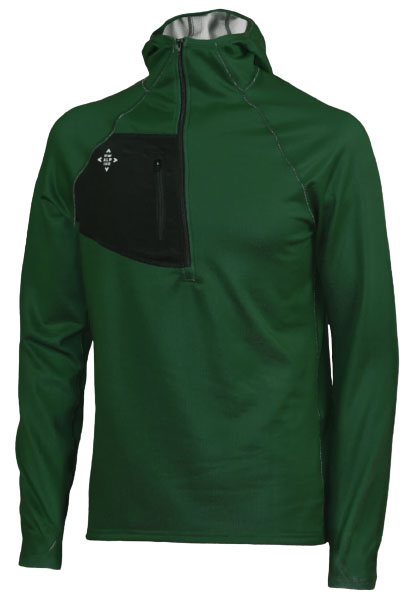 Materials: 92% polyester, eight% spandex
Materials: 92% polyester, eight% spandex
Category: Midweight
Weight: 11 oz.
What we like: Durable enough to exist worn as an outer layer.
What we don't: Expensive for polyester.
NW Alpine certainly isn't a household name, only this small Portland, Oregon, company designs and constructs alpine climbing clothes on par with the all-time. Although they only make a scattering of items, each of their products is a study in quality over quantity. And their Black Spider Hoody is one of our favorite baselayers: Information technology'southward comfortable, warm and breathable, and has unmatched durability. In fact, we've put ours through half dozen years of climbing abuse—much of the fourth dimension without a jacket over tiptop—and it has yet to develop any holes or tears.
All that said, the Black Spider Hoody won't earn you also many style points: Information technology lacks the odor resistance of merino and is available in simply a few simple colors. Furthermore, $129 is a hefty toll tag for a polyester baselayer, and it tin often be hard to detect in stock online or in stores. However, the most impressive immovability of any baselayer we've worn—combined with features similar an under-the-helmet hood and breast zip—set the Black Spider Hoody apart as a highly functional and long-lasting functioning piece.
Run into the Men'due south NW Tall Black Spider See the Women's NW Alpine Black Spider
Best of the Residual
7. REI Co-op Merino 185 Half-Zip ($ninety)
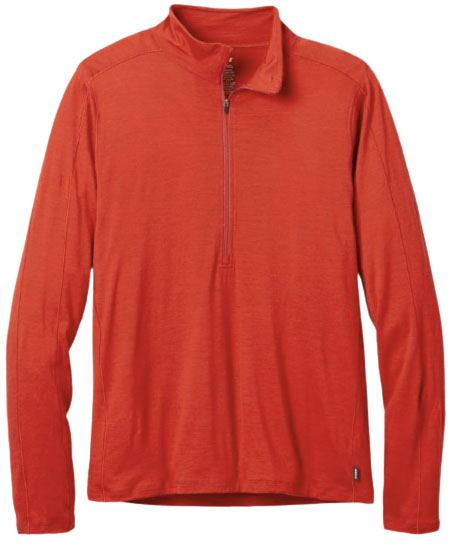 Material: 100% merino wool
Material: 100% merino wool
Category: Midweight
What we like: A soft, stretchy, and well-fabricated baselayer.
What we don't: Pricey for an REI product.
Of all of REI Co-op's in-business firm products, their merino baselayer is one of our favorites. It's correct on the same playing field as heavy hitters like Smartwool and Icebreaker, which is quite a feat given that those companies specialize in wool layering pieces. The Co-op recently updated their Merino Midweight Half-Zip design (200g/m²) to the Merino 185. Information technology drops a fiddling warmth with the thinner construction, only like its predecessor, the Merino 185 is soft, has a practiced amount of stretch, and wicks wet effectively. And almost importantly, it can handle everything from backpacking to cross-country skiing with ease.
Different many REI products, the Merino 185 One-half-Zip doesn't come at much of a discount, which is why nosotros have it ranked here. The 185g/m² thickness is a noticeable pace down in warmth from Icebreaker'southward popular 200 Oasis Coiffure only but $five less, although you do become a front zilch and college neckband on the REI. And for but $fifteen more, you can get the legendary Smartwool 250 above, our pinnacle selection, which is slightly thicker and much warmer at 250g/thou². We actually like the REI and take had nothing only positive experiences with it thus far, but we're not set to dethrone the Smartwool just yet.
See the Men'southward REI Merino 185 Half-Zip See the Women'due south REI Merino 185 Half-Zip
8. Patagonia Capilene Air Hoody ($149)
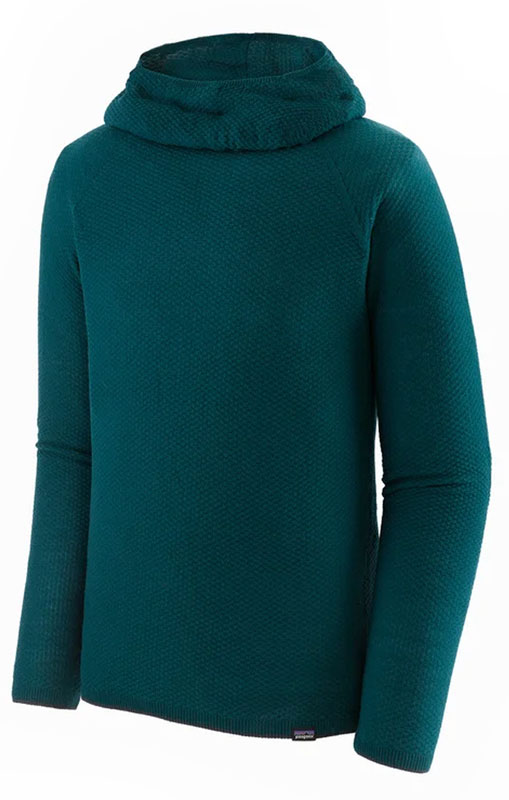 Materials: 51% merino, 49% polyester
Materials: 51% merino, 49% polyester
Category: Midweight
Weight: 6.ix oz.
What we like: Amazing warmth in a tiny package; responsibly sourced wool.
What nosotros don't: Expensive; lacks durability.
Patagonia's Capilene collection runs the gamut from thermal-weight baselayers to lightweight t-shirts and long-sleeve layers for hiking, and the midweight Capilene Air Hoody stands out as one of our favorites in the lineup. Known for leading the charge in their dedication to sustainable environmental practices, Patagonia outfitted the Capilene Air with recycled polyester (49 per centum), and the net effect is a responsibly made and truly innovative piece. With a balaclava-fashion hood, seamless structure, and a heat-trapping merino/polyester blend, the Capilene Air provides a massive amount of warmth in a relatively thin and lightweight package.
Although in theory the polyester make-upward of the Capilene Air gives it a crash-land in durability, we developed multiple holes and runs on our hoody in a matter of weeks. Furthermore, it is noticeably permeable to current of air, and the fabric tends to pill and human action as catch-all for hair, fuzz, and more than. For all these reasons, the Capilene Air is best worn nether a layer or two, unlike a highly durable baselayer similar the NW Alpine Black Spider Hoody in a higher place. But with dandy smell resistance, impressive wicking and drying properties, and one of the warmest, coziest hoods nosotros know of, it makes a fantastic adjacent-to-pare piece.
See the Men's Patagonia Capilene Air See the Women'southward Patagonia Capilene Air
9. Icebreaker 200 Oasis Coiffure ($95)
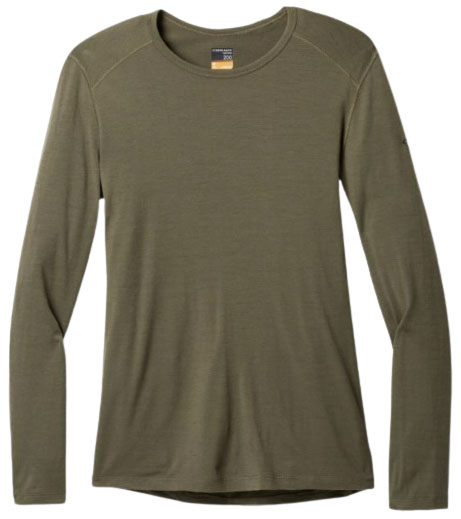 Textile: 100% merino wool
Textile: 100% merino wool
Category: Midweight
Weight: 11.8 oz.
What nosotros like: Softer against the skin than Smartwool.
What we don't: Slim fit and dense weave lags behind in breathability.
The Oasis Coiffure from Icebreaker is equally versatile equally any baselayer on this list. Information technology'south fabricated from 100 percent merino wool, is super soft, and has a functioning fit that works well for skiing and cool-weather condition hiking. And because of the clean styling and plethora of colorways and designs, you lot easily can wear information technology equally a standalone piece.
If y'all're considering the Haven, information technology's a head-to-head matchup with the Smartwool Merino 250 above. Both models are made from 100 percent merino, and the prices are similar (the zero-neck version of the Oasis is $105). Both are comfortable, wick moisture well, and don't trap odor similar synthetics. That said, we give the slight edge to the Smartwool because the dumbo weave of the Icebreaker'southward fabric doesn't release hot air quite as efficiently. Despite having a lighter fabric weight (200 vs. 250g/m²), it can start to feel muggy when y'all're working up a sweat. On the flip side, the Icebreaker wins out in side by side-to-skin softness, making information technology the better selection for those that prioritize comfort higher up all else.
Run across the Men'south Icebreaker 200 Oasis See the Women's Icebreaker 200 Haven
10. Woolx Glacier Long Sleeve Coiffure ($150)
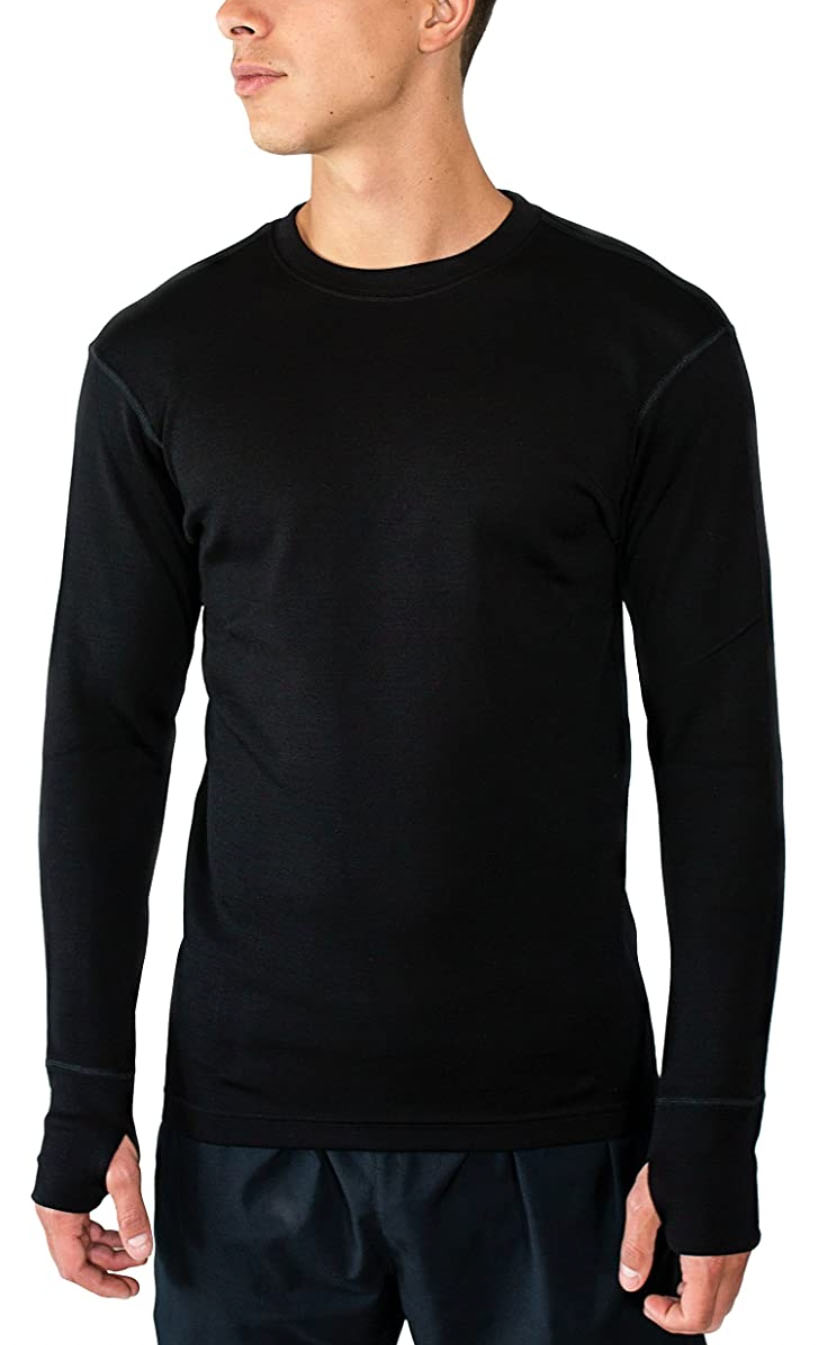 Textile: 100% merino wool
Textile: 100% merino wool
Category: Heavyweight
Weight: 1 lb. ane.6 oz.
What we like: Very warm and soft; a corking value for an all-merino baselayer.
What we don't: Because of the thickness and cut, it's non ideal for high-output activities.
Woolx is a pocket-sized New York-based company that doesn't become the hype of a Smartwool or Icebreaker, but their thick Glacier is a cozy and well-built heavyweight baselayer. Made with 100 pct merino wool, this slice is much warmer and more substantial than the midweight and lightweight options on the list. And because it'south merino, it'south however soft confronting the pare and breathes well. We've used the Glacier for everything from skiing and snowshoeing to coincidental use and have come away very impressed.
Stacked up against our tiptop heavyweight selection, the Patagonia R1 Air Goose egg-Cervix, the Woolx Glacier Long Sleeve Crew is noticeably thicker and warmer. Unfortunately, Patagonia doesn't provide a g/m² spec for the R1, merely the Glacier's 400g/m² is unmistakably best suited for the coldest winter days, which may be good or bad depending on your intended use. It also costs an additional $30 more than the Patagonia, doesn't come in a women's version, and has a decidedly relaxed fit that leaves more room for air to movement around. For working hard in frigid temps, we requite the border to the R1 Air, but the Woolx has its place equally a premium wool alternative for less intensive activities.
Run into the Men's Woolx Glacier
eleven. Odlo Natural + Kinship Warm Long-Sleeve ($100)
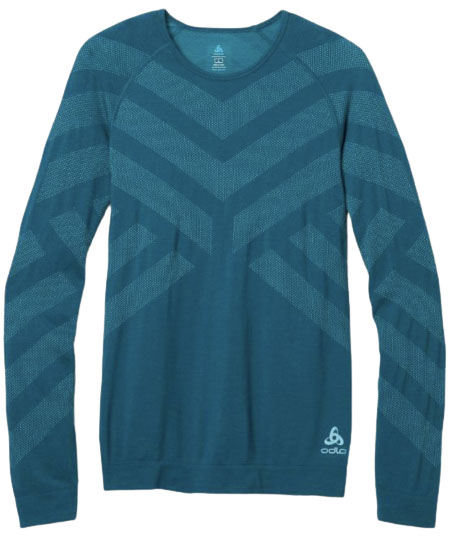 Materials: 52% merino, 41% polyester/nylon, 6% elastane
Materials: 52% merino, 41% polyester/nylon, 6% elastane
Category: Lightweight
Weight: half-dozen.6 oz.
What we like: Snug fit and great ventilation is platonic for active pursuits.
What we don't: Not our outset choice for resort skiing.
Odlo emerges from Norway with a lineup of thoughtful baselayers congenital for a range of activities and conditions. Our go-to for ski touring this past wintertime, their Natural + Kinship Warm blends merino wool with stretchy polyester and nylon for a long sleeve that excels in mild temperatures and while edifice rut. You get great breathability thank you to the shirt'south mapped ventilation zones, and we've found moisture wicking to be top-notch. Farther, the performance-oriented fit is snug yet stretchy, and Odlo even eliminated seams forth the shoulders for condolement while conveying a pack. To top it off, build quality is splendid, with both our tiptop and bottoms property upwardly corking after a couple months of frequent use.
While we love the Natural + Kinship Warm for high-output activities similar ski touring and cross-land skiing, it'southward less appealing equally a resort baselayer. You tin can go a lot warmer with a midweight option like the Smartwool Merino 250 above, and many will appreciate a more relaxed fit for lunch or après at the club. On the other paw, we're large fans of the fashionable patterning along the body and sleeves (and it'southward also available in a half-zip version). Added up, nosotros actually like what Odlo has done with the Natural + Kinship Warm, making it one of our favorite merino blends here. For warm-weather adventuring, Odlo likewise makes the Kinship Light Crew, which uses soft Tencel fibers (sustainably sourced from wood) rather than wool.
See the Men's Odlo Natural + Kinship Warm Run across the Women'southward Odlo Natural + Kinship Warm
12. Arc'teryx Rho LT Zip-Cervix ($125)
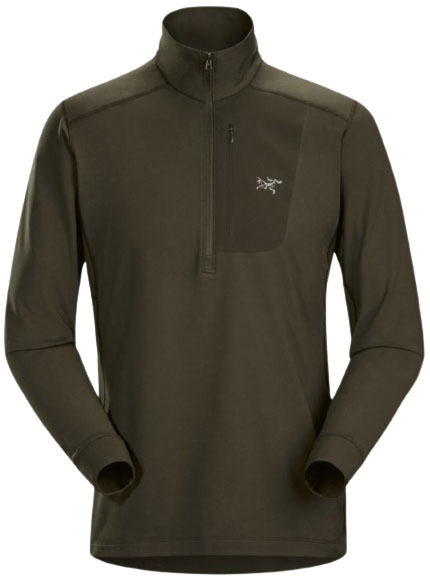 Materials: 84% polyester, 16% elastane
Materials: 84% polyester, 16% elastane
Category: Light/midweight
Weight: seven.6 oz.
What nosotros like: Soft and cozy for a polyester baselayer and features a nothing pocket.
What we don't: Expensive and non versatile as an outer layer.
Arc'teryx places a premium on high performance, which shows in their baselayer drove. Their Rho serial is designed to keep you warm in a variety of wintertime and shoulder season activities and includes the expedition-weight AR ("all-circular") model and the LT ("lightweight") here. Combining polyester with a generous dose of elastane, the zero-neck LT falls betwixt our light and midweight categories, making it an ideal layering slice under a midlayer or shell during low-output activities. Nosotros generally adopt merino baselayers for their ameliorate next-to-skin experience, but the Rho LT stands out with a soft brushed interior, and information technology doesn't hurt that its synthetic build is much more than durable than wool.
Arc'teryx paid attention to a number of modest details with the Rho LT. Gusseted underarms and a slight drop hem increase mobility, and a laminated attachment pocket on the breast for men (arm for women) are great for storing small items like chapstick or a credit card. $125 is a high toll to pay for a non-merino baselayer (almost constructed options here are about half the toll), and the Rho LT'southward trim, technical fit means it doesn't function well as a standalone slice. That said, it'southward hard to get wrong with Arc'teryx's quality—the Rho is built to last. And if you have a tendency to run cold or want a winter-fix baselayer, the fleece-lined Rho AR offers a heavy dose of insulation and cozy loft at an impressively low weight—almost a half-pound less than the all-merino Woolx above.
See the Men'due south Arc'teryx Rho LT See the Women's Arc'teryx Rho LT
13. Black Diamond Solution 150 Merino Crew ($135)
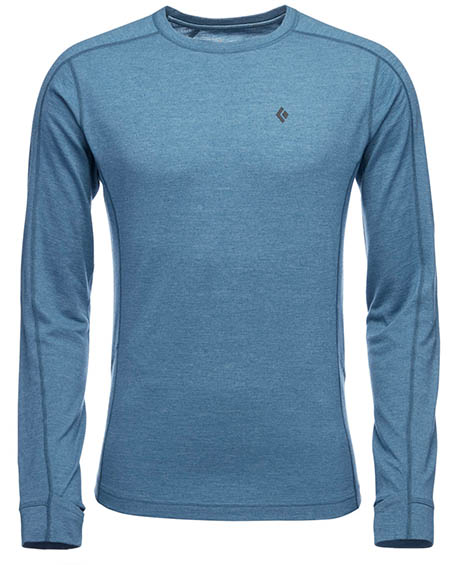 Materials: 78% merino, 22% polyester
Materials: 78% merino, 22% polyester
Category: Lightweight
Weight: 6.7 oz.
What nosotros similar: The benefits of merino, plus wet wicking and durability.
What nosotros don't: Expensive for a lightweight baselayer.
Black Diamond's Solution Wool lineup fabricated waves at its debut, namely for its innovative NuYarn engineering science. Many manufacturers weave fibers together with merino to reap the benefits of both, just NuYarn takes it to the next level, wrapping nylon with extra-fine merino fibers for a thread that exudes technical performance downwardly to its literal core. The end consequence is impressive: Compared to a baselayer like the Smartwool Merino 150 above, the Solution 150 is noticeably more durable and dries out very quickly when wet (great news for those who are prone to working upwards a sweat).
Subsequently wearing the Solution 150 for vi days straight while hiking in Patagonia, nosotros were impressed with how well information technology held its shape and resisted odor. Under a loaded backpack, the get-go shoulder stitching was comfortable and mitigated pressure level points, and the thumb loops are sleek and well constructed. In fact, our biggest gripe with the Solution 150 is its cost—at $135, it's $50 more than Smartwool'due south comparable baselayer pinnacle (the Merino 150 Crew). But cost aside, the Solution 150 has solid all-around performance and volition last longer than near merino baselayers.
See the Men'due south BD Solution 150 Merino See the Women'south BD Solution 150 Merino
xiv. Ortovox 185 Rock'N'Wool Long Sleeve ($110)
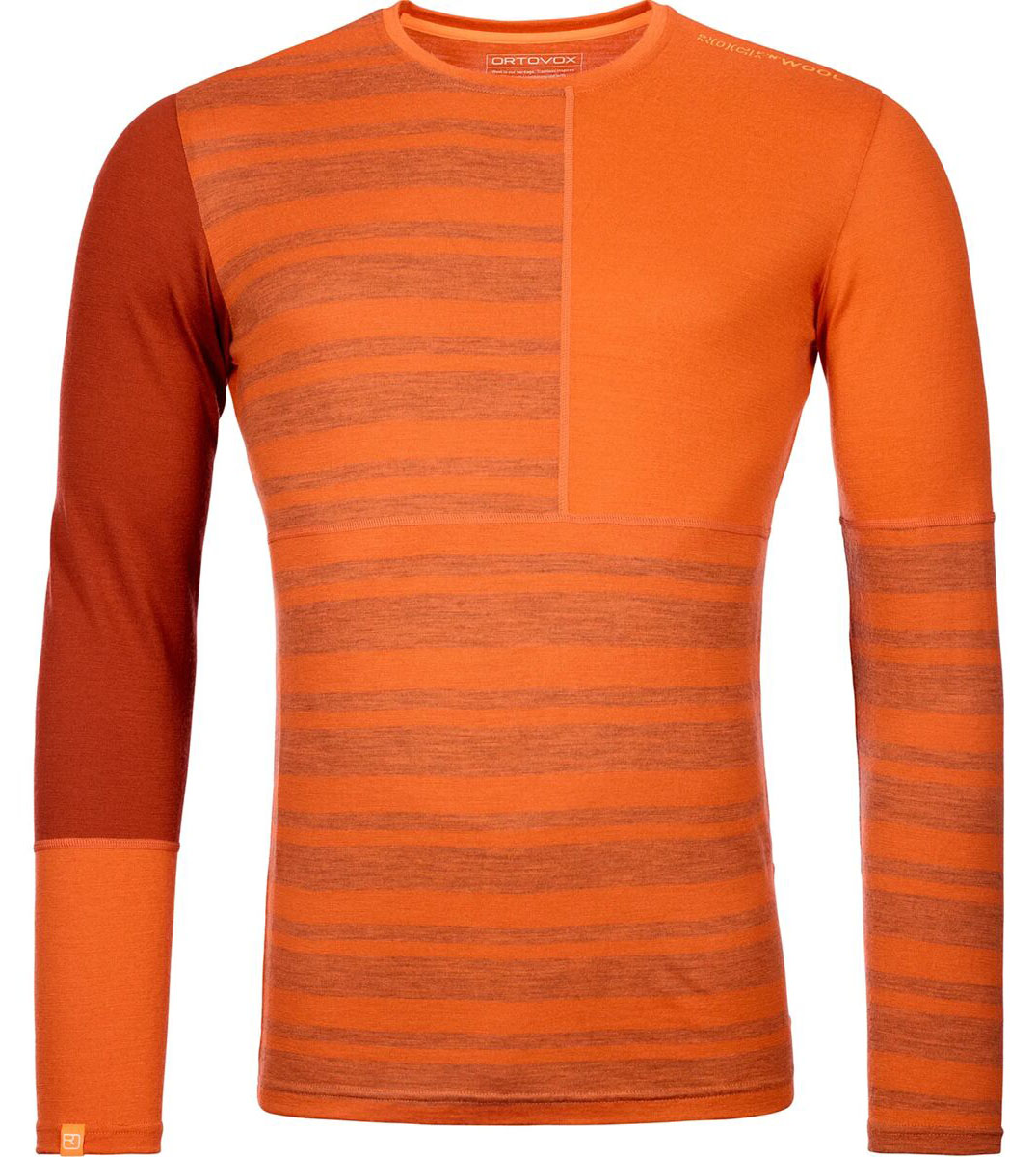 Material: 100% merino wool
Material: 100% merino wool
Category: Light/midweight
Weight: 6.9 oz.
What nosotros like: Great styling and super-soft mitt feel.
What we don't: Expensive and lacks durability.
Nosotros'll start with the basics: The Ortovox 185 Merino long-sleeve crew is a standard merino baselayer. Much similar the chart-topping Smartwool, it's made with 100 percent wool, which means you go uncompromised odor resistance, great temperature regulation, and a cozy, soft touch. At 185 k/m², it'due south lighter than the Smartwool 250, meaning it's more suitable for shoulder-season or loftier-output activities. That said, the thin fabric, paired with the fact that information technology's non blended with a synthetic material, does make u.s.a. concerned virtually the Ortovox's durability (even Smartwool's 150-weight shirt features a merino/nylon blend).
Simply hither is where the Stone'N'Wool stands out: Starting time, the Ortovox Wool Promise ensures that their product comes from ethical and certified sheep farms. And 2nd, nosotros just tin't get plenty of the styling on the Rock'N'Wool—if you want a merino baselayer with some flair, the multi-colored designs really stand out in the conservative and largely bland baselayer market. For a versatile, breathable next-to-skin layer that tin can take you straight from peel track to après, the Ortovox 185 is an eye-catching merely still very capable selection.
Run into the Men'southward Ortovox Rock'N'Wool LS See the Women'southward Ortovox Stone'N'Wool LS
15. REI Co-op Lightweight Base Layer Crew ($forty)
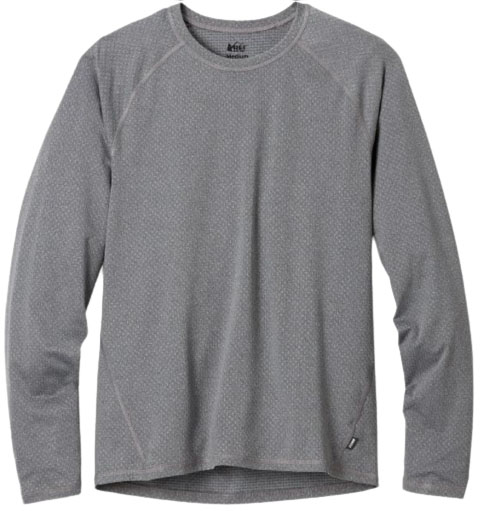 Materials:92% polyester, viii% spandex
Materials:92% polyester, viii% spandex
Category: Lightweight
Weight: 6.5 oz.
What we like:Elementary yet functional.
What nosotros don't:Not super comfortable or a high performer.
In terms of bang for your buck, it's hard to summit REI baselayers. For $twoscore, the Lightweight Crew offers most of the performance of the more than expensive options above in a simple yet functional blueprint. Additionally, REI honed things in even further with 8 pct spandex in the construction, which gives it a nice, stretchy feel. Paired with the matching bottoms, you tin pick up a total long underwear fix for $80 ($25 cheaper than just a merino pinnacle from Smartwool).
What are the downsides of the REI? We've institute the lightweight model works well for mild resort skiing days, hiking, and casual use, but you may non be warm plenty in frigid temperatures. Of note, REI does offer a warmer version (the Midweight Crew) for $50. And although the Co-op's fabric is comfortably silky, information technology can't compete with merino or fifty-fifty Patagonia's Capilene in terms of softness and condolement (and it'due south even more than decumbent to holding in body odor). These issues aside, the REI Lightweight (or Midweight) Crew is a skilful mode to kit yourself out this winter on a budget.
See the Men's REI Lightweight Crew Run into the Women's REI Lightweight Crew
16. Icebreaker 260 Zone Crew ($140)
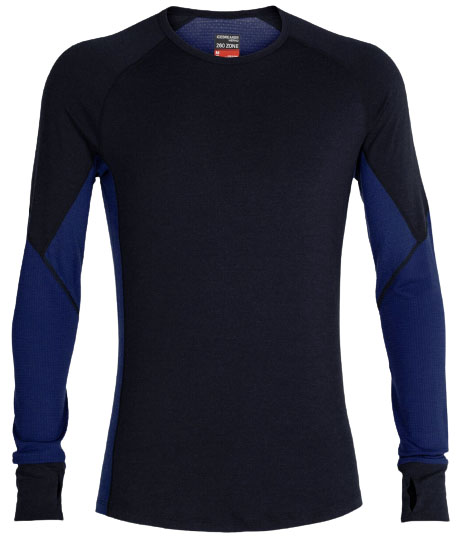 Materials: 97% merino wool, iii% elastane
Materials: 97% merino wool, iii% elastane
Category: Midweight
Weight: 13.seven oz.
What we like: A warm nevertheless breathable baselayer with mesh panels for actress ventilation.
What we don't: Not everyone volition honey the tight fit.
For working difficult in cold weather, the Icebreaker 260 Zone Crew offers one of the best combinations of warmth and breathability. Using Icebreaker's BodyFitZone construction, it combines 260-weight merino (spun with elastane for durability and stretch) with strategically placed panels of airy merino mesh in wet-prone areas like the underarms and dorsum. The net result is a temperature-regulating baselayer that tin can dump serious heat but will still proceed you warm where and when you need it to.
Every bit we've come to wait from Icebreaker, everything about the 260 Zone exudes quality, from the flatlock seams to prevent friction to the well-executed thumb loops. Similar the Odlo above, the stretchy 260 has a decidedly snug fit, which isn't for everyone but does add a nice performance camber. And importantly, you nonetheless get neat mobility with gusseted underarms and raglan sleeves, along with a drop-tail hem for added coverage around back. The Smartwool 250 above is roughly the same warmth and costs $35 less, but the Icebreaker'south more than athletic fit and torso-mapped mesh panels give it the edge for truly high-output use. Both are excellent midweight options, and a final decision will come down to your objectives and anticipated uses (coincidental vs. agile wear).
Meet the Men's Icebreaker 260 Zone Coiffure See the Women's Icebreaker 260 Zone Coiffure
17. 50.Fifty. Bean Silk Underwear Crewneck ($fifty)
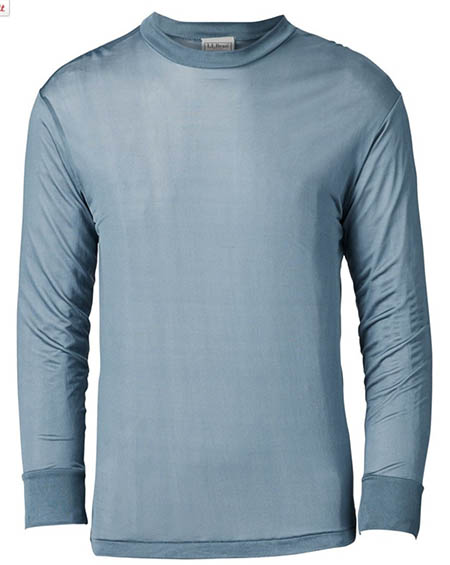 Cloth: 100% silk cloth
Cloth: 100% silk cloth
Category: Lightweight
What we similar: Cozy and nifty for layering.
What we don't: Lacks the performance of merino or polyester.
Silk can't compete with merino or polyester in terms of warmth, moisture wicking, and immovability, but it's not without its identify in the baselayer world. Those who prize comfort in a higher place all else might choose silk for sleeping, effectually camp, and other low-output activities. Furthermore, silk is and then thin that it can easily be worn underneath slim-plumbing equipment layers without creating extra bulk. And for only $50, L.50. Bean'due south Silk Underwear is well made and more durable than most silk options.
We don't recommend wearing the Silk Underwear Crewneck for any sort of loftier-output activity—it simply does not breathe as well as merino or polyester. Moreover, if yous want it to last, the shirt should always be layered with a mid or outer crush. In the end, silk falls short of the wool and polyester options in a higher place in nearly every performance category. But if you prioritize condolement above all else and like the feel of silk, the 50.L. Bean Crewneck is worth a expect. For the same price, REI's Silk Long Underwear Coiffure Shirt is largely like just with a looser fit.
See the Men'southward L.L. Bean Silk Crewneck See the Women's L.50. Edible bean Silk Crewneck
Baselayer Comparison Table
| Baselayer | Toll | Materials | Category | Weight | g/k² |
|---|---|---|---|---|---|
| Smartwool Merino 250 i/4-Nada | $105 | 100% merino wool | Midweight | 10 oz. | 250g/chiliad² |
| Patagonia Capilene Midweight | $69 | 100% recycled polyester | Light/mid | 6.two oz. | 147g/m² |
| Helly Hansen Lifa Stripe Coiffure | $45 | 100% polypropylene | Lightweight | v.1 oz. | 125g/thousand² |
| Patagonia R1 Air Zip-Cervix | $119 | 100% recycled polyester | Heavyweight | x.two oz. | Unavail. |
| Smartwool Merino 150 Crew | $85 | 87% merino wool, xiii% nylon | Lightweight | 6 oz. | 150g/grand² |
| NW Tall Blackness Spider Hoody | $129 | 92% polyester, 8% spandex | Midweight | 11 oz. | 194g/thou² |
| REI Co-op Merino 185 Half-Zip | $90 | 100% merino wool | Midweight | Unavail | 185g/k² |
| Patagonia Capilene Air Hoody | $149 | 51% merino, 49% polyester | Midweight | six.9 oz. | 190g/m² |
| Icebreaker 200 Oasis Coiffure | $95 | 100% merino wool | Midweight | xi.eight oz. | 200g/m² |
| Woolx Glacier LS Crew | $150 | 100% merino wool | Heavyweight | 1 lb. 1.half-dozen oz. | 400g/m² |
| Odlo Natural + Kinship Warm LS | $100 | 52% merino, 29% polyester, xiii% nylon, six% elastane | Lightweight | 6.6 oz. | Unavail. |
| Arc'teryx Rho LT Zilch-Neck | $125 | 84% polyester, 16% elastane | Light/mid | seven.half-dozen oz. | 190g/1000² |
| Black Diamond Solution 150 | $135 | 78% merino, 22% polyester | Lightweight | 6.vii oz. | 150g/m² |
| Ortovox Rock'N'Wool LS | $110 | 100% merino wool | Light/mid | vi.9 oz. | 185g/m² |
| REI Co-op Lightweight Crew | $40 | 92% polyester, viii% spandex | Lightweight | half-dozen.5 oz. | Unavail. |
| Icebreaker 260 Zone Crew | $140 | 97% merino wool, 3% elastane | Midweight | 13.7 oz. | 260g/chiliad² |
| L.Fifty. Bean Silk Crewneck | $l | 100% silk fabric | Lightweight | Unavail. | Unavail. |
Baselayer Buying Advice
- Baselayer Materials
- Important Strengths and Weaknesses
- Breathability
- Odor Prevention
- Durability
- Warmth
- Baselayer Categories: Insulation Weight
- Coiffure Neck vs. Quarter or Half Zips
- Fit
- Cardinal Baselayer Features
- Sustainability
- What About Baselayer Bottoms?
- Layering Systems: Base, Mid, and Outer Layers
Baselayer Materials
Merino Wool
Merino wool, despite a higher cost than synthetics, is our recommended baselayer material for a number of reasons. It's ultra soft and comfortable, has superior temperature regulation, and resists odor. Granted, merino wool baselayers are expensive and less durable than the polyester competition, amounting to roughly double the cost. Accept proficient care of them, nonetheless, and yous should be able to get at to the lowest degree a few seasons of extended use. Our elevation baselayer choice, the Smartwool Merino 250 ¼ Zip, is 100 percent merino. For more than data nearly the pros and cons of the material, check out our article: Merino Wool: Is It Worth It?
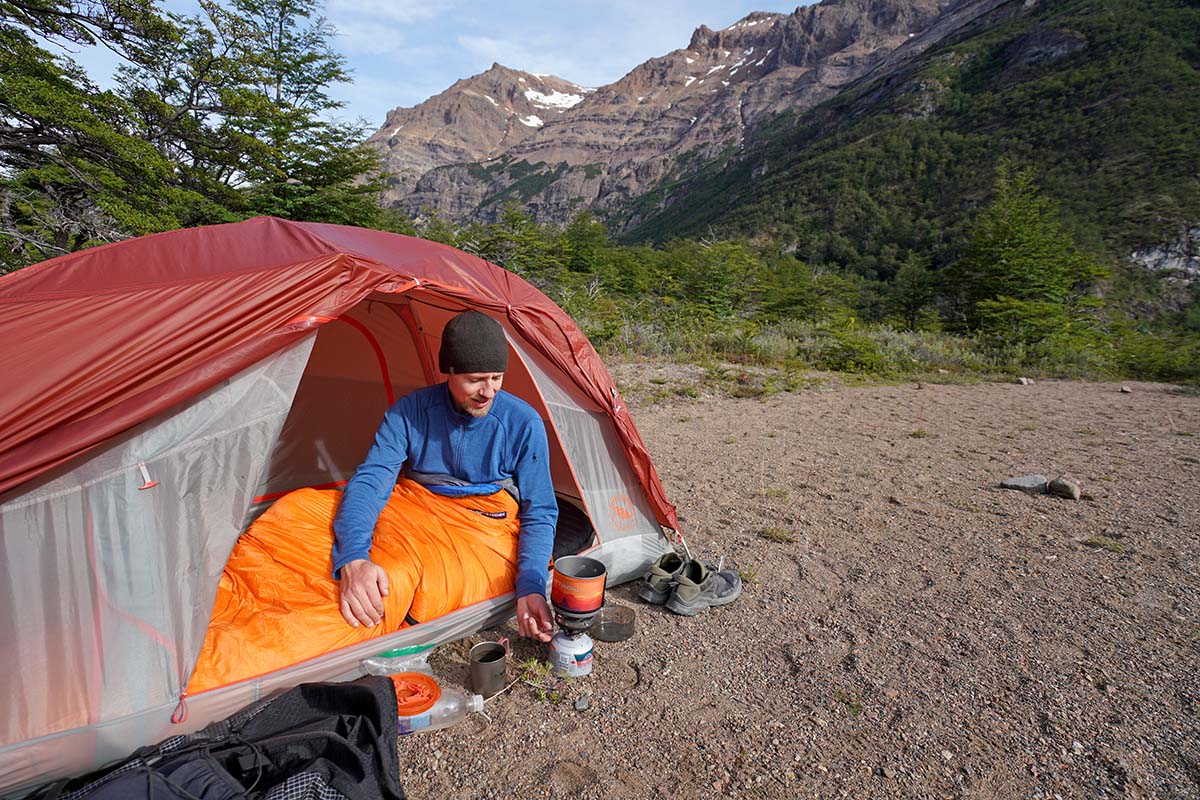
Polyester
For a cost-effective baselayer culling, you tin e'er turn to polyester. Led by Patagonia's legendary Capilene line, polyester fabrics can keep up in terms of moisture wicking and the comfort difference isn't that far off. The downside is stink prevention, which is an surface area of emphasis for many manufacturers. Thus far, odour-resistant polyesters nevertheless can't compete with the natural benefits of merino merely they are improving. In add-on, polyester fabrics don't regulate temperatures also, and so information technology's more of import to friction match the fabric weight with intended utilize and conditions (more on that below). Despite the downsides, polyester fabrics are what we recommend most often for resort skiers. At approximately half the price of a comparable merino option, the price saving is also significant to overlook.
Blends
It's non quite equally simple as deciding between an all-merino or all-polyester baselayer. Some performance-oriented brands are experimenting with blends that aim to offer the comfort and performance of merino wool with the durability and wet-wicking of polyester. The Patagonia Capilene Air, for case, weaves together 51 per centum merino wool with 49 percent polyester, while Black Diamond's NuYarn (as seen in the Solution 150 Merino) actually wraps merino fibers effectually a nylon core, and then weaves this manufactured thread together with polyester. The commonality of these types is that they are among the highest priced items in this market, so these blends are more about performance than price savings.
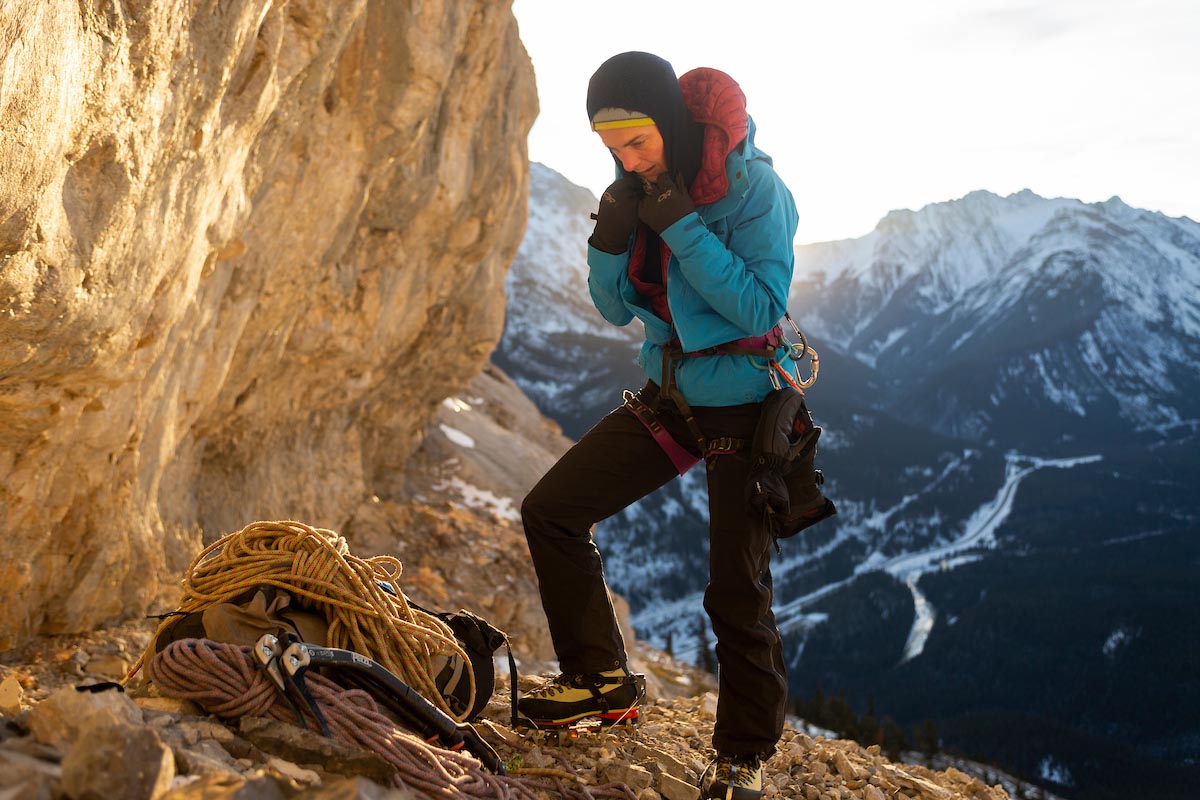
Silk
Silk is one of the softest and most comfy of the baselayer fabrics and packs an impressive amount of warmth into a lightweight, sparse design. But as the demand for temperature-regulating baselayers rises, silk is largely going out of vogue. It just can't go along up with merino or polyester in terms of moisture wicking and turns into a sweat lodge during high-output activities. Moreover, silk is far less durable than polyester and should e'er be worn under a mid or outer layer to protect from UV rays and chafe. And finally, it does not resist odor like merino and should be hand-washed. Nosotros but include i silk option on our list for a reason, just it does have its advantages as a dedicated sleep shirt or extra layer in town.
Important Strengths and Weaknesses
Breathability
The breathability of a baselayer is dependent on a number of factors, including the type and quality of the fabric, thickness, and openness of the weave. In full general, lightweight merino wool will offer the best in terms of breathability, although some high-quality lightweight synthetics are close. This ways that for high-exertion activities where you will be working up a sweat (remember ski touring, cross-country skiing, biking, and climbing) it'due south probably worth spending more to get a higher-performing baselayer like the Smartwool Intraknit 200 or Icebreaker 150 Zone. Spending less, particularly on a thick baselayer, will yield less breathability. Whether or non that's a deal-breaker is up to personal preference and your tendency to overheat.
Merino: Excellent
Blends: Splendid
Polyester: Very good
Silk: Non skillful
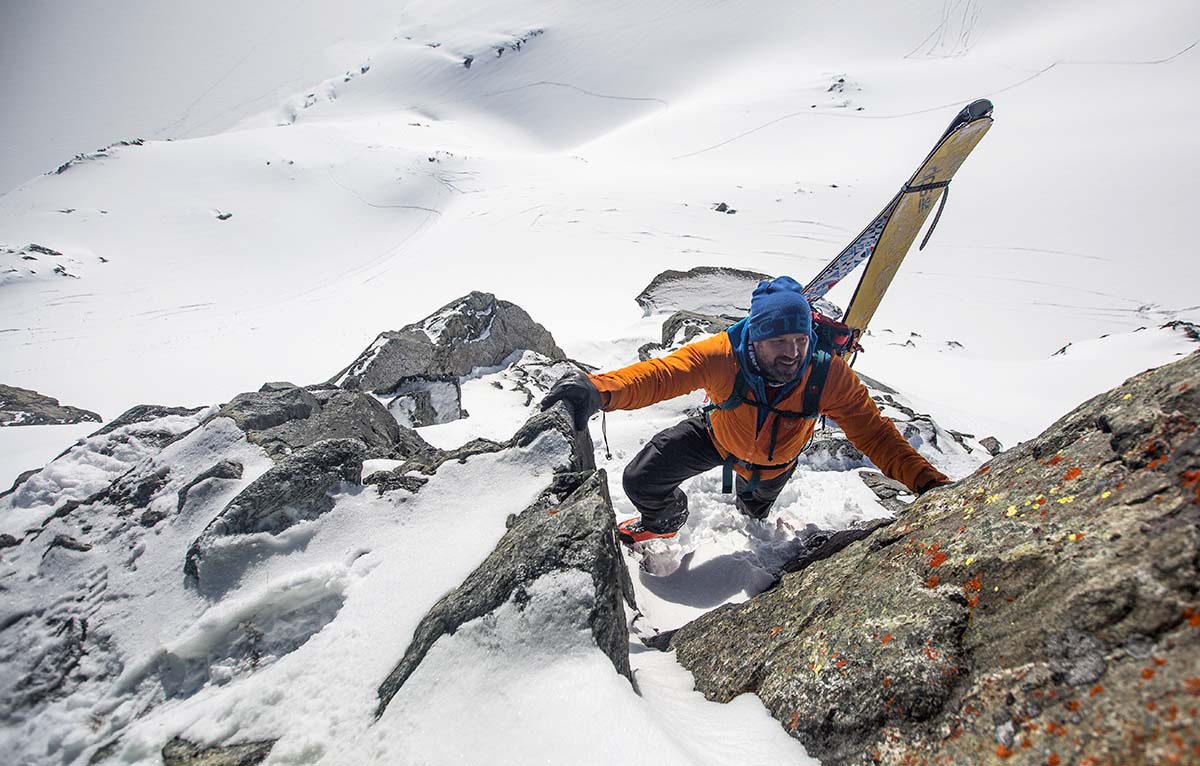
Smell Prevention
Merino wool excels at pulling moisture abroad from your skin, and less sweat build up ways less stink build up. If you're taking an extended backcountry trip and don't want to behave multiple baselayers or rinse them each night, merino is the way to go. Some synthetics do fine for odor prevention, provided you aren't working up a huge sweat. For example, we've hiked for extended periods in Patagonia's Capilene Midweight in cool weather and take been impressed with its odour resistance. Only null beats merino in keeping you dry and stink free.
Merino: Very skilful
Blends: Good
Polyester: Not good
Silk: Non adept
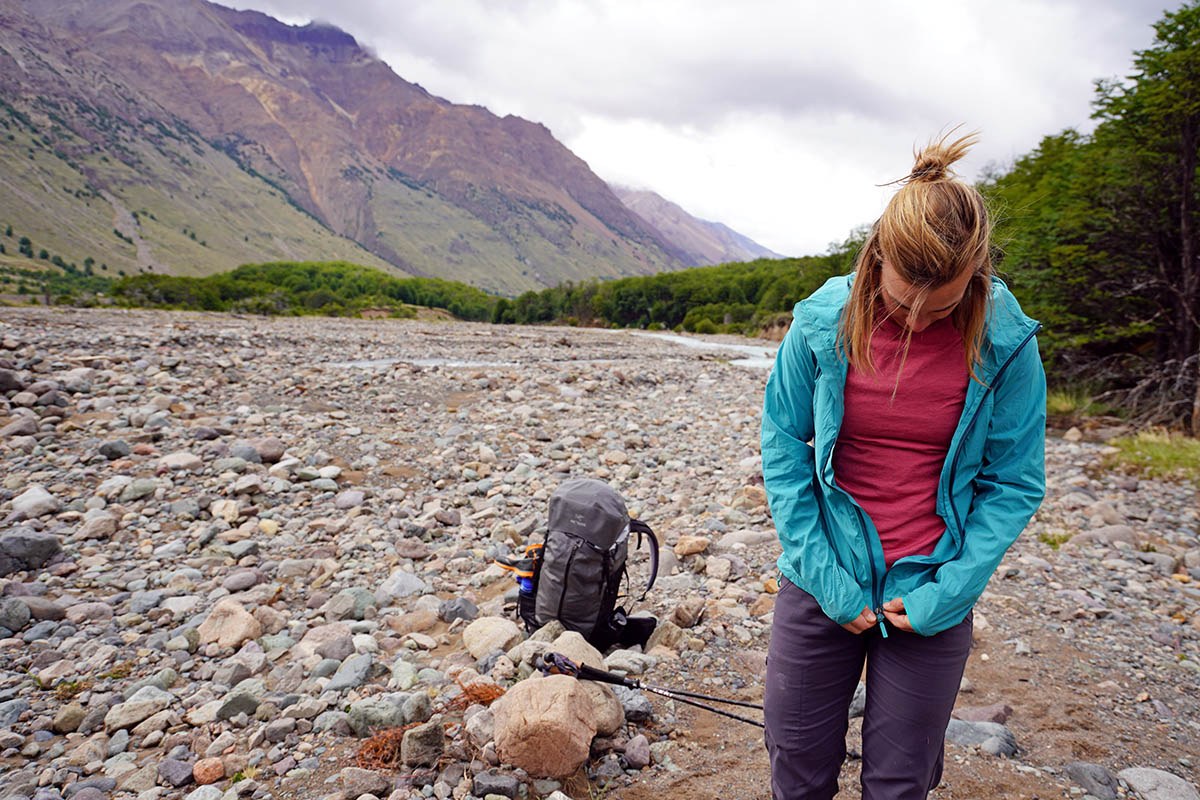
Durability
Here is where the tide changes: Merino is super soft only prone to developing small-scale holes over fourth dimension that somewhen hamper the functioning of the production, whereas synthetics should last for multiple seasons. To put this in perspective, nosotros usually get a flavour or two out of a standard lightweight merino baselayer, fifty-fifty from the pinnacle brands and by following their washing instructions (common cold h2o and line dry). Admittedly, these shirts get a lot of employ, simply that'southward notwithstanding a very curt lifespan. Merely with synthetics, one or two seasons would exist on the short terminate of the spectrum and nosotros would hope for more like 3 or 4.
Some companies are blending wool and synthetics to increase the strength of the baselayer without compromising adjacent-to-peel condolement, which is a skilful idea in our opinion. Nosotros oasis't noticed much of a driblet in terms of comfort or performance, but merino/synthetic blends are a pace up in immovability. Notwithstanding, if we're wearing a baselayer without annihilation overtop, nosotros'll e'er opt for a fully synthetic piece such as the NW Tall Blackness Spider Hoody.
Polyester: Excellent
Blends: Very adept
Merino: Not good
Silk: Not expert
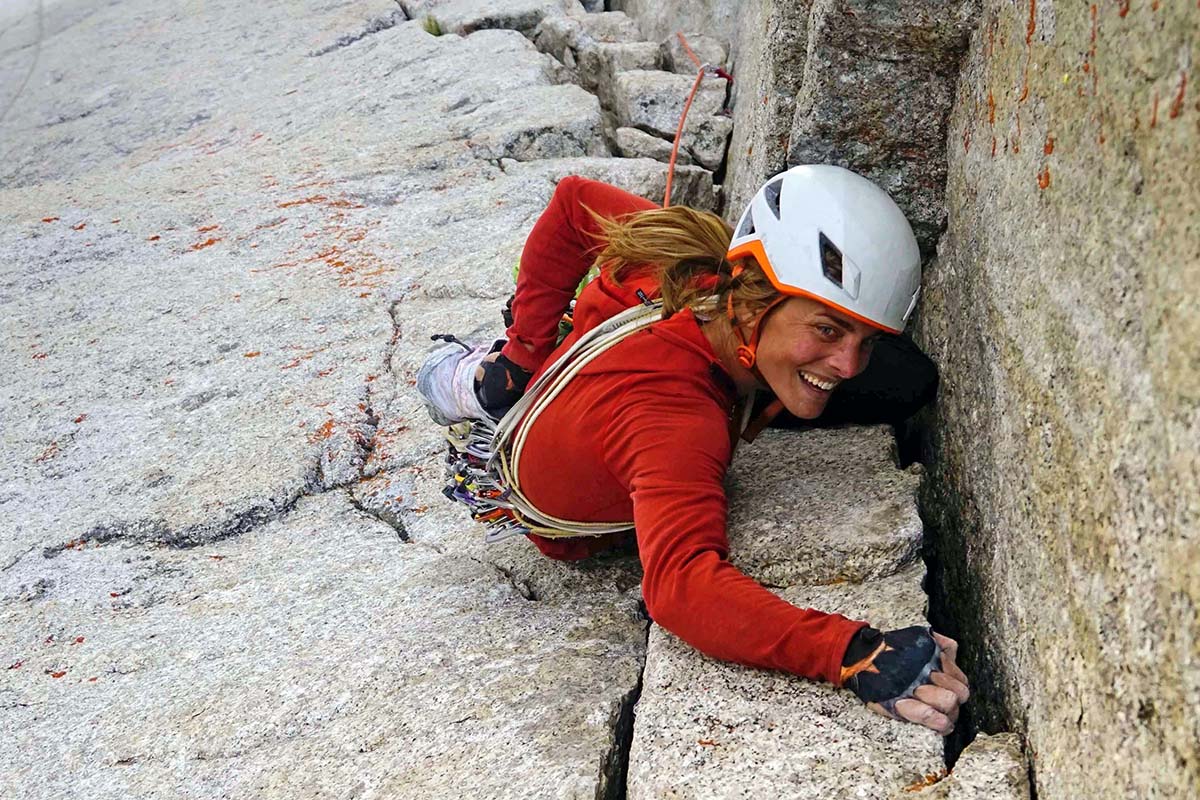
Warmth
Out of all the fabrics we've mentioned, merino has the all-time estrus-trapping properties. In general, you get a better warmth-to-weight ratio with merino than with polyester, and information technology regulates temperature better also. The same shirt that keeps yous warm in the winter will continue you cool when you're sweating upwards the skin runway in the shoulder seasons. Silk, too, is noticeably warm for its thin makeup, only its lack of breathability is a strong drawback. Information technology'south too of import to consider if you'll be wearing your baselayer every bit an outer layer—while merino doesn't exercise much to block current of air, some polyester fabrics (such as Patagonia'southward Capilene) are so tightly woven that they accept the ability to resist calorie-free gusts. And proceed in mind that warmth is directly related to the thickness of the material too, which we discuss in the Insulation Weight section below.
Merino: Excellent
Blends: Very good
Polyester: Good
Silk: Good
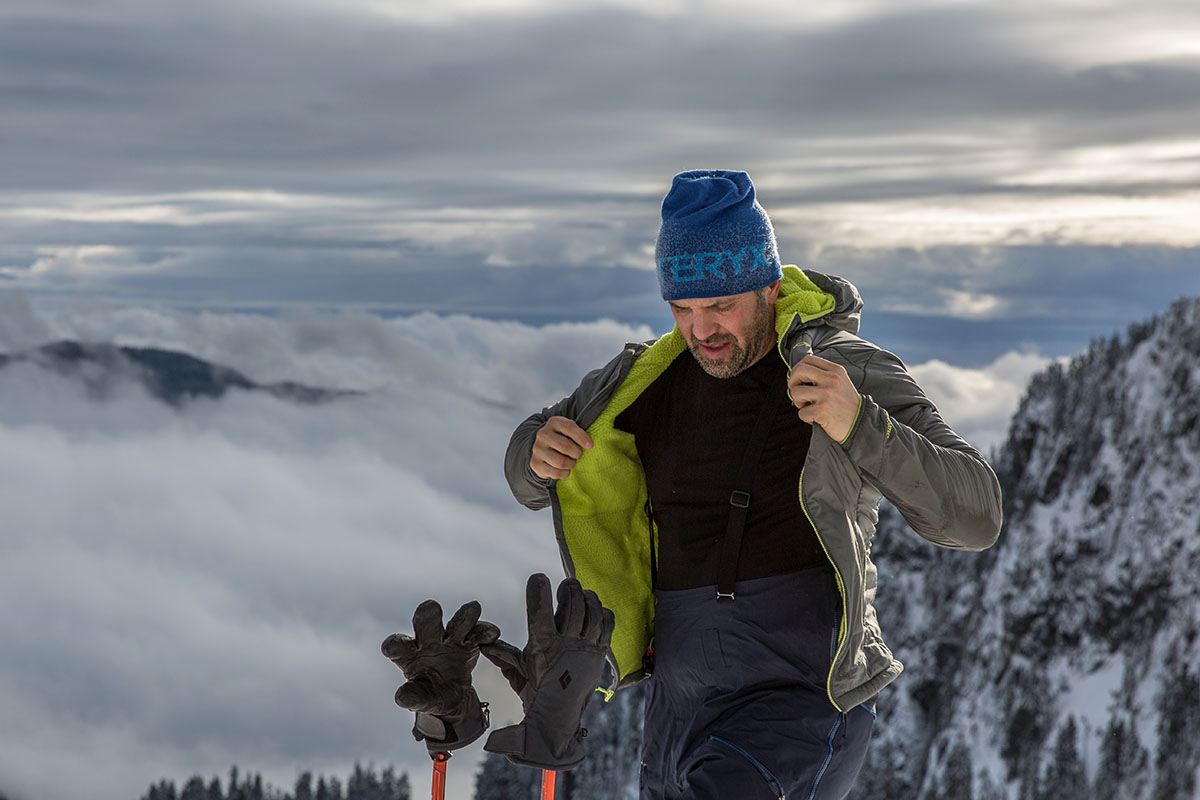
Baselayer Categories: Insulation Weight
Lightweight
Logically, lightweight baselayers are the best breathers but do the least in keeping you warm. This is where merino wool shines—information technology does an admirable task of temperature regulation for the weight and thickness. However, the thinner the merino, the less durable information technology becomes. For this reason, nigh lightweight baselayers are made of polyester. These are ideal for early flavour skiing, bluebird days, and loftier-output activities such as cross-country skiing and cold-weather running. Resort skiers and winter climbers will likely opt for a warmer and cozier midweight baselayer.
Midweight
For the widest diversity of conditions, a midweight baselayer makes the almost sense. It will provide the warmth y'all demand even so still be breathable plenty for physical exertion, peculiarly when made with loftier-quality merino or polyester. Midweight baselayers are the most popular choice for downhill skiers: They're plenty warm for the lift ride up but you lot are unlikely to overheat on the descent. They are less popular than lightweight baselayers for hiking or ski touring in moderate conditions as the actress warmth corresponds with a drib in the fabric'south ability to regulate temperatures (even merino can get too hot in warm temperatures). But in cool spring and fall conditions, a midweight baselayer can perform neat equally an outer layer and is the platonic adjacent-to-skin layer for resort skiing on cold days.
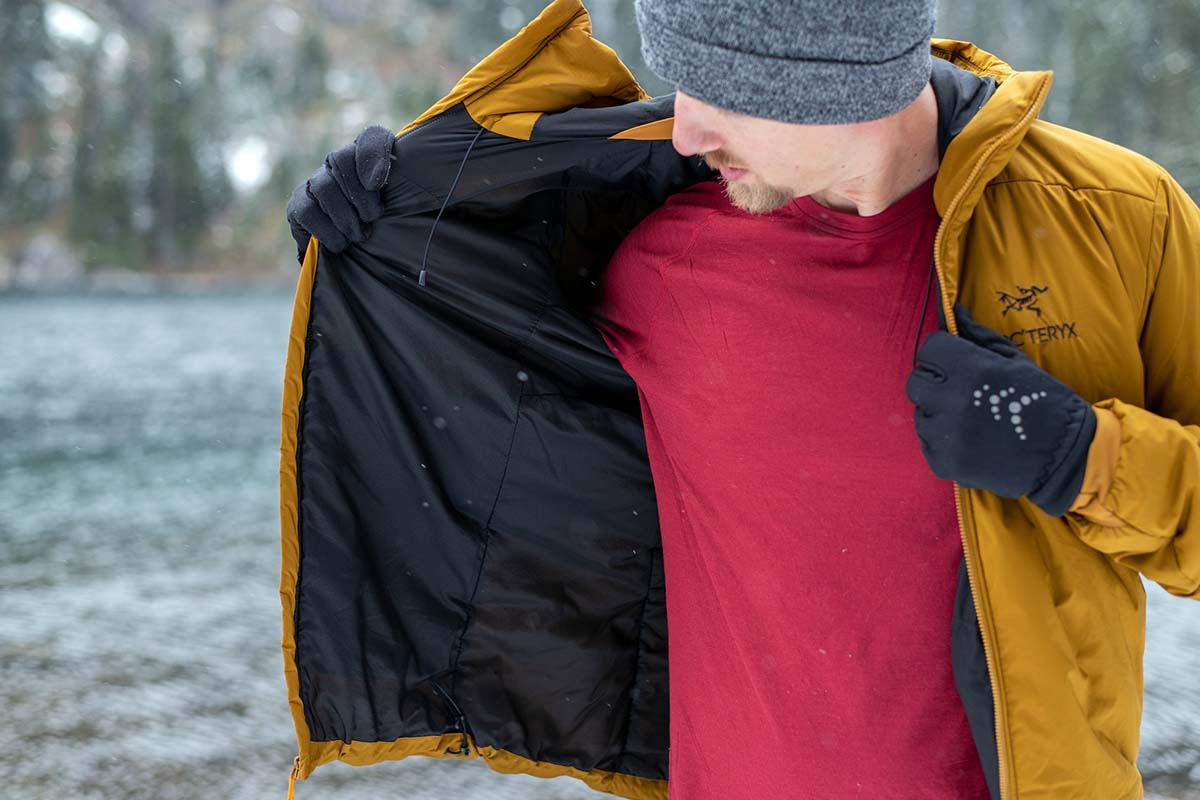
Heavyweight
Heavyweight baselayers are specialty items for cold temperatures or if you'll exist relatively sedentary. The extra thickness inhibits breathability and it'southward easy to start sweating even on curt walks. Keep in mind that you don't need all of your insulation from a unmarried clothing, and as a result, you can always add together warmer layers on top of a lite or midweight baselayer. Just for winter mountaineering, extreme common cold, or low-output activities around camp, a heavyweight baselayer can be the top of coziness. If you do get this route, we love the Woolx Glacier Long Sleeve Crew, which is a 400g/1000² all-merino baselayer that nevertheless breathes decently well. Patagonia's Thermal Weight Capilene can become swampy unless it'due south very common cold.
Coiffure Neck vs. Quarter or Half Zips
Nearly every baselayer on the market place is made in a number of styles, including long-sleeve crew and half/quarter-length zippered shirts. Many folks opt for a crewneck manner, merely at that place are a number of reasons to call up about a zippered shirt. One upside is the ability to adapt to changing weather conditions. Nil up for added warmth at the start of the climb, and unzip as you work upwards a sweat. And if you want to remove the shirt altogether, information technology's squeamish not having to take off your helmet to do and so. Furthermore, the extra coverage you go with the raised collar is a nice boost in warmth, and we've even plant that quarter or half-zip long sleeves accept a decent look for around town. The downside is the collars can bomb around if you unzip the shirts while running, and having a zipper on your adjacent-to-skin layer isn't as comfortable as the cleaner crew style.

Fit
For optimal operation, baselayers need to accept a snug fit. This helps the fabrics depict moisture away from your skin most efficiently. Some folks like wearing their baselayers for casual use, and that's when a dedicated operation product like Odlo Natural + Kinship Warm is less useful. The shirt conforms to your trunk like a performance piece should, merely it's far also tight to wear anywhere else. A product similar the REI Co-op Merino 185 Half-Nada is on the opposite end of the spectrum, with a roomier fit that sacrifices a trivial in moisture wicking and breathability. But it's a great choice for those that adopt a dual apply baselayer/casual shirt. In the cease, your decision is a personal one, and we recommend looking at fit based on intended use and preferences on style.
Key Baselayer Features
Baselayers can range from simple, featureless crew tops similar the Patagonia Capilene Midweight Crew to hooded one-half-zips with a chest pocket (the NW Tall Black Spider Hoody, for example). If y'all know you'll be layering a mid or outer layer over your baselayer, the simpler the better. All the same, those who wear their baselayer as an outer layer volition appreciate zip pockets and thumb loops. And climbers and skiers will benefit from a tight hood or balaclava that fits nether their helmet. Furthermore, some baselayers fifty-fifty have the capability of blocking lord's day rays (measured by the UPF rating). As usual, information technology will help to place what you'll be using your baselayer for before determining what features y'all demand.
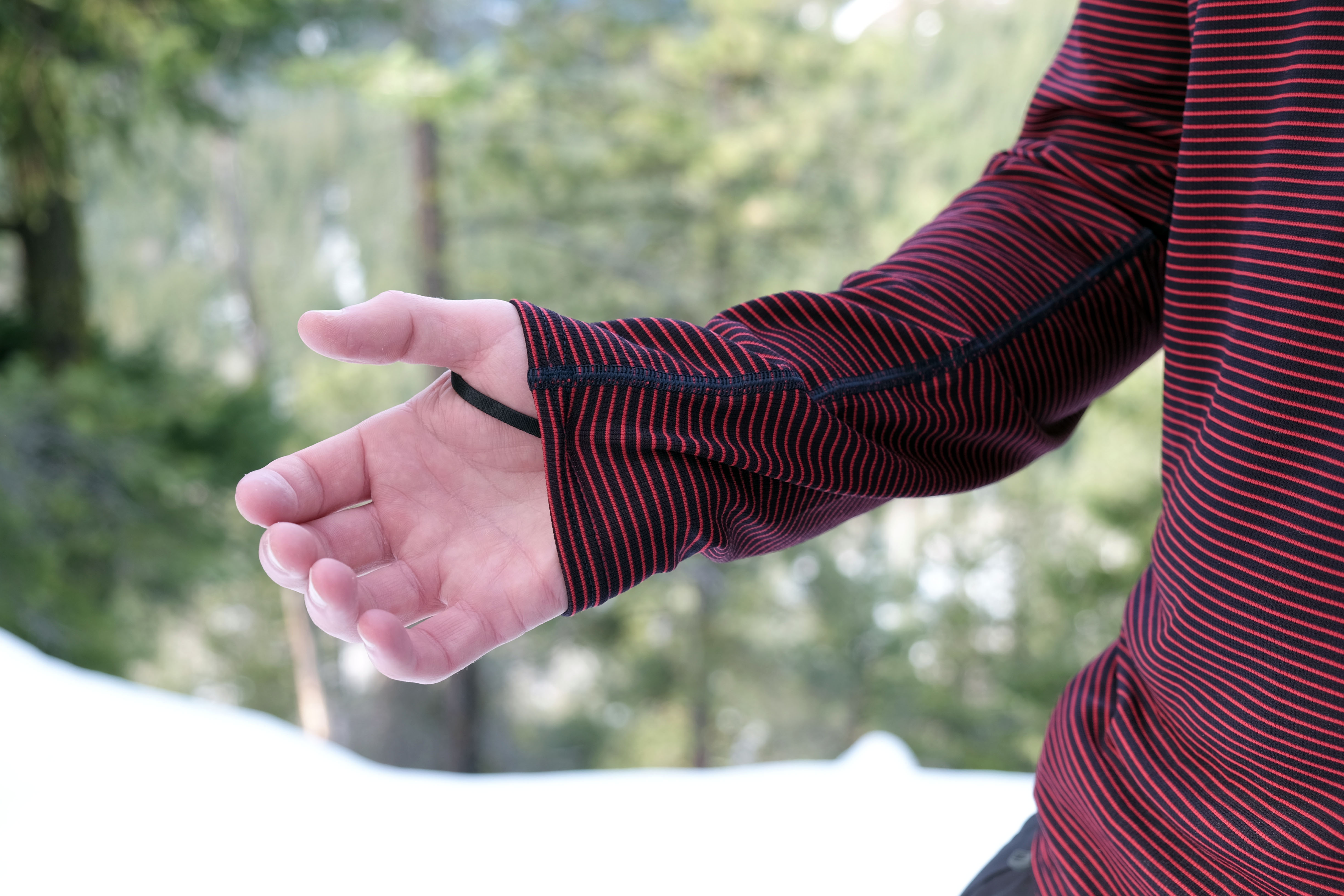
Sustainability
The focus on sustainability has been increasing in the outdoor industry over the past several years, and baselayers are no exception. In this category, there currently are two fundamental trends: responsibly sourced wool and the utilise of recycled constructed materials. The former indicates that sheep were treated humanely and in accordance with strict fauna welfare and ecology standards (there are a number of certifications, including the Responsible Wool Standard and ZQ-certified wool). Nosotros've likewise begun to see more companies utilizing recycled materials, which cuts down on fossil fuel consumption and reduces the amount of plastics beingness produced overall (Patagonia's Capilene Midweight is fabricated from 100-percent recycled polyester). All in all, we appreciate these efforts and are eager to encounter more than brands come up on board.
What Almost Baselayer Bottoms?
Most baselayers on this list have a matching bottom with the same structure and a similar or identical cost. For organization sake, we list the tops here as they are more than popular, but the bottoms are readily bachelor and share the aforementioned pros and cons. In general though, maintaining a warm core volition do much more for your unabridged body's condolement than keeping your legs warm. But given that at that place'south no demand to choose—and provided that near nothing is cozier than a pair of long johns—we're huge proponents of baselayer bottoms too.
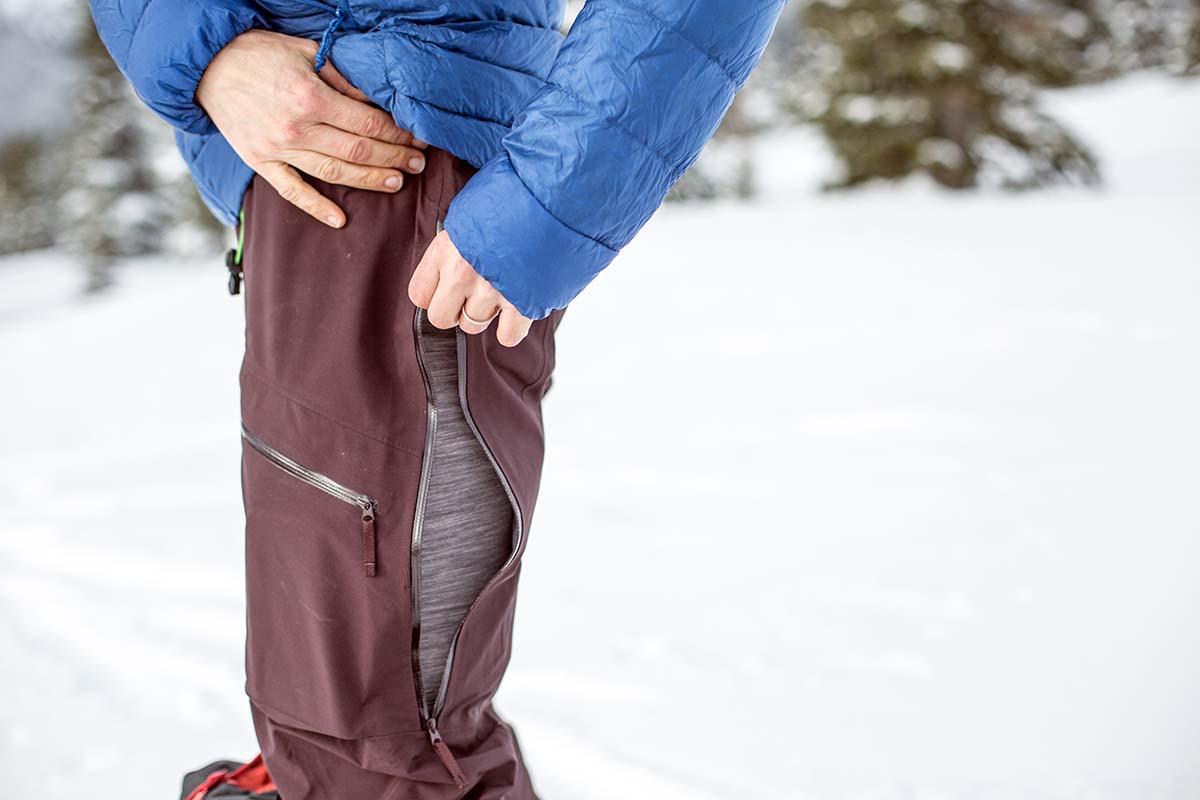
Layering Systems: Base, Mid, and Outer Layers
To get the near out of your technical clothing, it's important retrieve of everything equally a system. Each piece relies on the layers around it to perform well. As an example, if you take a baselayer that wicks moisture well, merely are wearing a fully rubber mid or outer layer, it won't affair how squeamish of a merino fabric you have: You'll still be wet and miserable. As such, have the time to put together mid and outer layers that are every bit high-performing every bit the baselayers listed to a higher place.
Baselayers
Baselayers have two main functions: warmth and moisture wicking. Whether constructed with silk, wool, polyester, or a blend, a baselayer is fabricated to retain your body'southward heat while transporting moisture away from the skin. And these two features work together—keeping the body dry will in turn atomic number 82 to more warmth. Baselayers are worn beneath a midlayer or trounce during the wintertime months, or equally an outer layer during the fall and leap for activities like hiking, biking, and climbing. The thickness and material of your baselayer will have large impacts on warmth and breathability, so make sure to keep this mind when making a purchase.
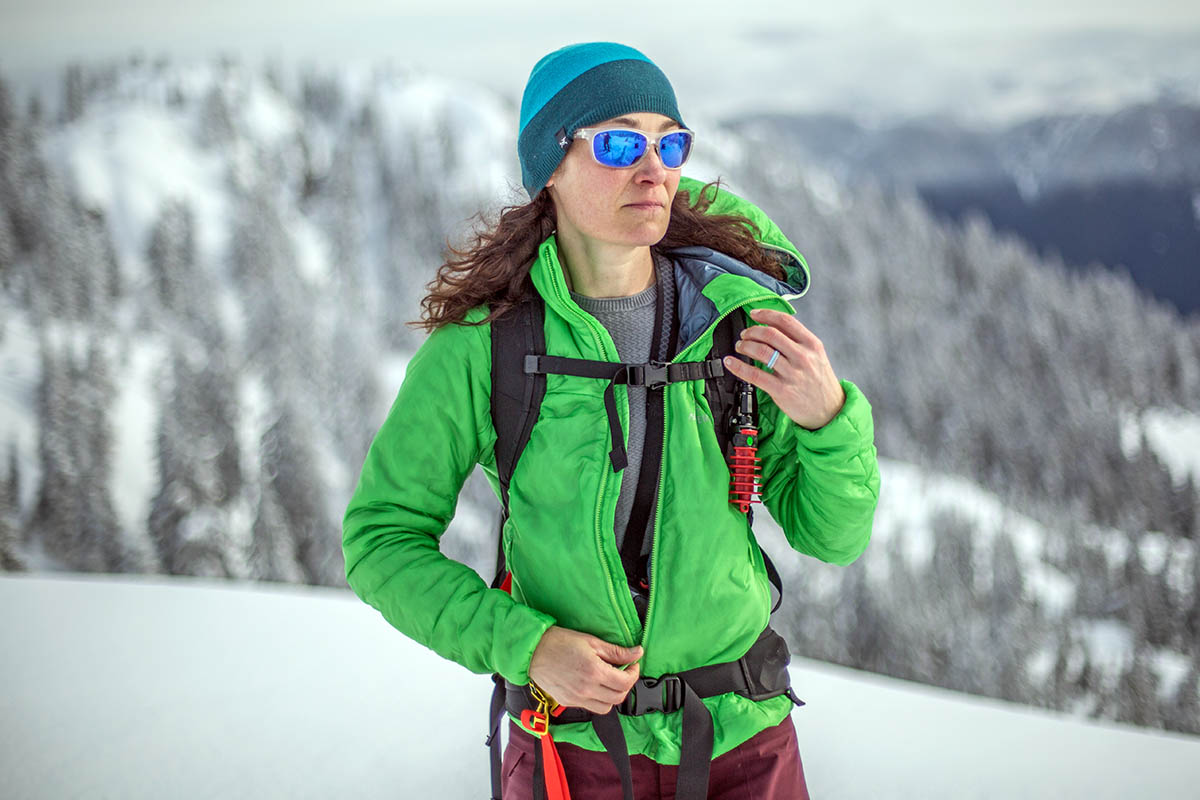
Midlayers
For loftier-output activities, such as hiking, backpacking and climbing, breathability is peak priority. Nosotros recommend a fleece jacket or synthetic jacket for balancing warmth and ventilation. High performers include the Arc'teryx Atom LT and the R line of fleeces from Patagonia. If you but plan to take hold of your insulating layer during downtimes, such as hanging around camp after the dominicus goes downwards, consider a warm and super packable down jacket. Skiing is a similar story, and conditions volition dictate the best midlayer for you. Options tin range from a puffy downwards jacket to a light fleece.
Outer Layers
Outer layers are the almost specialized office of the arrangement, and their complex designs tin go quite pricey. A waterproof, breathable, and packable rain jacket is needed for activities like climbing and hiking/backpacking. Winter conditions are much harsher, so durability takes precedence for ski jackets. Their designs offer more pockets for storing gear or personal effects and a longer fit to protect you from snow sneaking through. There are also hardshell jackets that blur the lines, mixing the weight of a rain jacket with the functioning (and extra cost) of a ski jacket.
Back to Our Tiptop Baselayer Picks Back to Our Baselayer Comparison Table
Source: https://www.switchbacktravel.com/best-baselayers